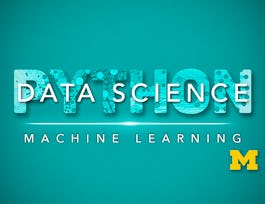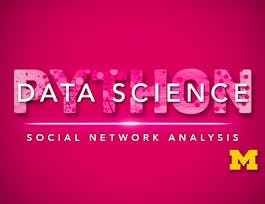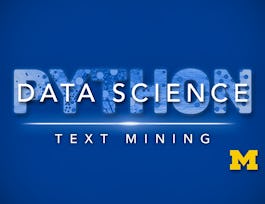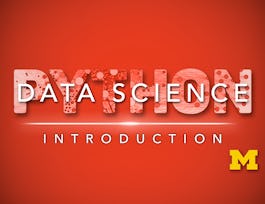This course will introduce the learner to information visualization basics, with a focus on reporting and charting using the matplotlib library. The course will start with a design and information literacy perspective, touching on what makes a good and bad visualization, and what statistical measures translate into in terms of visualizations. The second week will focus on the technology used to make visualizations in python, matplotlib, and introduce users to best practices when creating basic charts and how to realize design decisions in the framework. The third week will be a tutorial of functionality available in matplotlib, and demonstrate a variety of basic statistical charts helping learners to identify when a particular method is good for a particular problem. The course will end with a discussion of other forms of structuring and visualizing data.


Applied Plotting, Charting & Data Representation in Python
This course is part of Applied Data Science with Python Specialization
Taught in English
Some content may not be translated

Instructor: Christopher Brooks
188,856 already enrolled
Included with 
Course
(6,222 reviews)
93%
What you'll learn
Describe what makes a good or bad visualization
Understand best practices for creating basic charts
Identify the functions that are best for particular problems
Create a visualization using matplotlb
Skills you'll gain
Details to know

Add to your LinkedIn profile
Course
(6,222 reviews)
93%
See how employees at top companies are mastering in-demand skills

Build your subject-matter expertise
- Learn new concepts from industry experts
- Gain a foundational understanding of a subject or tool
- Develop job-relevant skills with hands-on projects
- Earn a shareable career certificate


Earn a career certificate
Add this credential to your LinkedIn profile, resume, or CV
Share it on social media and in your performance review

There are 4 modules in this course
In this module, you will get an introduction to principles of information visualization. We will be introduced to tools for thinking about design and graphical heuristics for thinking about creating effective visualizations. All of the course information on grading, prerequisites, and expectations are on the course syllabus, which is included in this module.
What's included
8 videos6 readings1 peer review1 app item1 discussion prompt
In this module, you will delve into basic charting. For this week’s assignment, you will work with real world CSV weather data. You will manipulate the data to display the minimum and maximum temperature for a range of dates and demonstrate that you know how to create a line graph using matplotlib. Additionally, you will demonstrate the procedure of composite charts, by overlaying a scatter plot of record breaking data for a given year.
What's included
7 videos2 readings1 peer review2 ungraded labs
In this module you will explore charting fundamentals. For this week’s assignment you will work to implement a new visualization technique based on academic research. This assignment is flexible and you can address it using a variety of difficulties - from an easy static image to an interactive chart where users can set ranges of values to be used.
What's included
6 videos3 readings2 peer reviews3 ungraded labs
In this module, then everything starts to come together. Your final assignment is entitled “Becoming a Data Scientist.” This assignment requires that you identify at least two publicly accessible datasets from the same region that are consistent across a meaningful dimension. You will state a research question that can be answered using these data sets and then create a visual using matplotlib that addresses your stated research question. You will then be asked to justify how your visual addresses your research question.
What's included
4 videos3 readings1 peer review2 ungraded labs
Instructor

Offered by
Recommended if you're interested in Data Analysis

University of Michigan

University of Michigan

University of Michigan

University of Michigan
Prepare for a degree
Taking this course by University of Michigan may provide you with a preview of the topics, materials and instructors in a related degree program which can help you decide if the topic or university is right for you.
Why people choose Coursera for their career




Learner reviews
Showing 3 of 6222
6,222 reviews
- 5 stars
67.03%
- 4 stars
23.21%
- 3 stars
6.26%
- 2 stars
1.97%
- 1 star
1.51%
New to Data Analysis? Start here.

Open new doors with Coursera Plus
Unlimited access to 7,000+ world-class courses, hands-on projects, and job-ready certificate programs - all included in your subscription
Advance your career with an online degree
Earn a degree from world-class universities - 100% online
Join over 3,400 global companies that choose Coursera for Business
Upskill your employees to excel in the digital economy
Frequently asked questions
Access to lectures and assignments depends on your type of enrollment. If you take a course in audit mode, you will be able to see most course materials for free. To access graded assignments and to earn a Certificate, you will need to purchase the Certificate experience, during or after your audit. If you don't see the audit option:
The course may not offer an audit option. You can try a Free Trial instead, or apply for Financial Aid.
The course may offer 'Full Course, No Certificate' instead. This option lets you see all course materials, submit required assessments, and get a final grade. This also means that you will not be able to purchase a Certificate experience.
When you enroll in the course, you get access to all of the courses in the Specialization, and you earn a certificate when you complete the work. Your electronic Certificate will be added to your Accomplishments page - from there, you can print your Certificate or add it to your LinkedIn profile. If you only want to read and view the course content, you can audit the course for free.
If you subscribed, you get a 7-day free trial during which you can cancel at no penalty. After that, we don’t give refunds, but you can cancel your subscription at any time. See our full refund policy.

